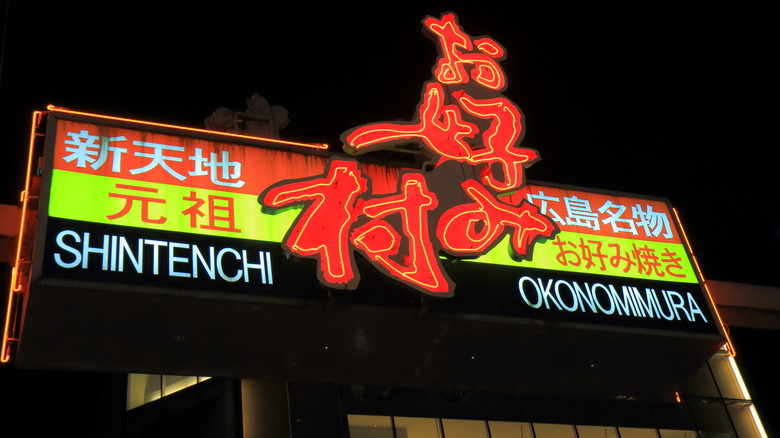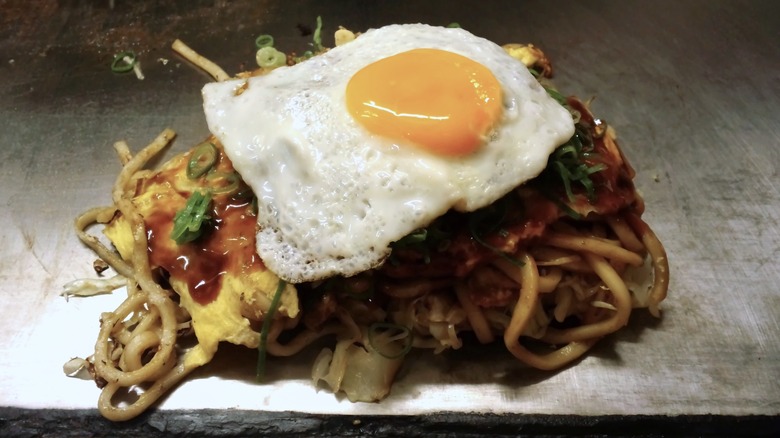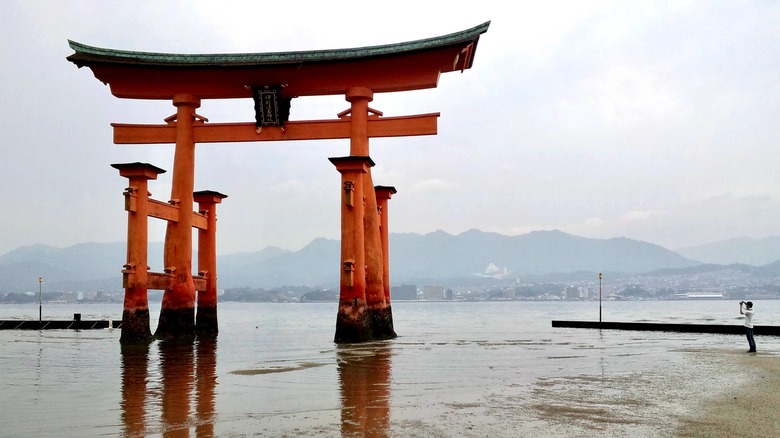This Makeshift Japanese Theme Park Is A Must-Visit For Foodies
There are theme parks, and then there are food theme parks. In both cases, arguably, nowhere does it better than Japan, which has helped make Universal Studios Japan and Tokyo Disneyland two of the world's most-visited theme parks. However, even at Japanese theme park resorts, the food can be hit-or-miss, with hotel breakfast buffets sometimes showing more concern for quantity than quality of food. This is where food theme parks, such as Okonomimura in the city of Hiroshima, enter the equation.
It's a simple concept: an indoor park where the theme is a certain dish, served up in different variations. Okonomimura's specialty is okonomiyaki, a kind of savory Japanese pancake heaped with cabbage and other fillings. The name of the dish, broken down into its constituent parts, just means "whatever you want, grilled." With "mura," the Japanese word for village, substituted for "yaki," Okonomimura roughly translates to Whatever You Want Village.
If that's not inviting enough, Okonomimura has 25 shops where you can watch your okonomiyaki being made in front of you, before eating it right off the griddle with a metal spatula. They're spread out over three floors in a building with an otherwise unremarkable exterior in the Shintenchi district. Look for the big Shintenchi/Okonomimura sign overhanging the street (pictured above). It's your gateway to food heaven and Hiroshima, a city where food is intertwined with post-war development.
Okonomimura and Hiroshima okonomiyaki's roots
An early version of okonomiyaki called issen yoshoku, made with shrimp and green onions, was around in Hiroshima even before World War II. However, the dish really caught on as the city rebuilt itself in the aftermath of the atomic bombing on August 6, 1945. That's when Hiroshima okonomiyaki developed into its current, cabbage-heavy style, layered with noodles and ingredients like pork, fried egg, okonomiyaki sauce, and seaweed flakes.
Street vendors in Shintenchi improvised with relief supplies, iron hotplates, and any ingredients on hand until the city cracked down on unlicensed stalls two decades later. This forced them to regulate and relocate to indoor settings, paving the way for Okonomimura, the mother of all food theme parks. At Okonomimura, you can watch them pour out the batter and assemble your okonomiyaki, layer by layer, on the griddle, which is built into the counter, teppanyaki-style. Shops like Eegai and Roku, both on the 4th floor, have English menus available.
The word okonomiyaki originated in the rival food mecca of Osaka, where the prevailing style has less cabbage, no noodles, and mixed instead of layered ingredients. Yet Hiroshima has made the dish its own. While the city's A-Bomb Dome serves as a sobering reminder of the war, Okonomimura now stands as a monument to its post-war food heritage. Though estimates vary, the city and surrounding prefecture (also named Hiroshima) reportedly hold anywhere from 1,700 to 2,000 okonomiyaki restaurants, the highest per capita of any region nationwide.
Other food theme parks and Hiroshima landmarks
Okonomimura may remain unmatched in its wealth of 25 shops, but it isn't Japan's only famous food theme park. Foodies in Greater Tokyo can visit the Shin-Yokohama Ramen Museum, where a replicated '50s streetscape complements seven different regional varieties of noodles. Outside the Universal Studios park in Osaka, the Citywalk shopping complex also contains a busy food court called Takopa with six counters specializing in takoyaki (octopus fritters).
If you're looking to go off-menu and be adventurous, however, you may want to leave behind the bubble of those places and trace your favorite regional food back to its local source. Hop on the bullet train in Osaka and you can be in Hiroshima in about 90 minutes. Even around Hiroshima, you'll find different areas outside Okonomimura serving unique okonomiyaki varieties.
From Hiroshima Peace Memorial Park, you can take a direct ferry to Miyajima Island, where another UNESCO World Heritage Site, Itsukushima Shrine, stands. The island is known for its anago (conger eel) okonomiyaki, served at restaurants near the shrine like Mato-chan. At low tide, you can cross the mud to the shrine's world-renowned floating torii gate and see barnacles and stray wishing coins stuck to it. At high tide, as water overtakes the gate again, you can retreat to the island, where sacred deer roam freely. Like the food paradise of Okonomimura, it's not without theme park appeal, as this same floating torii gate was the model for the one in Disney's EPCOT.


